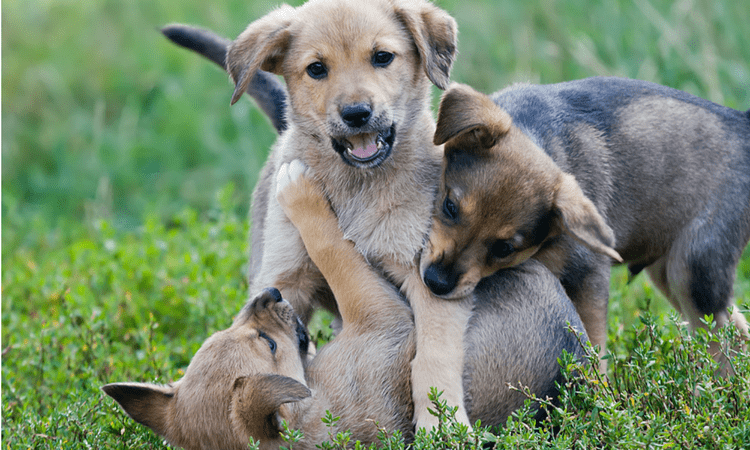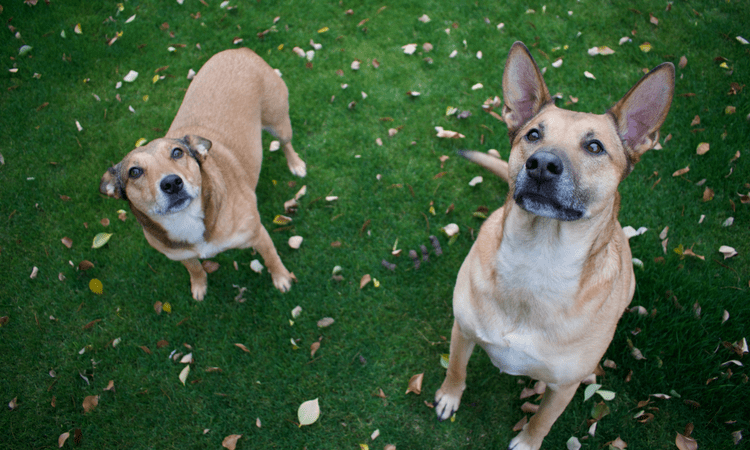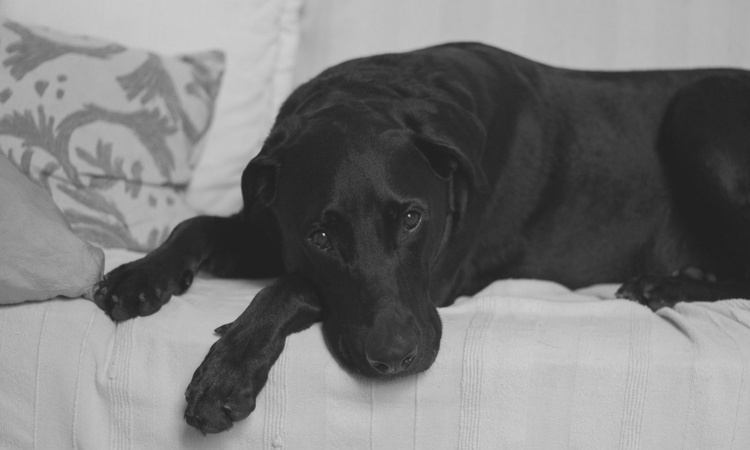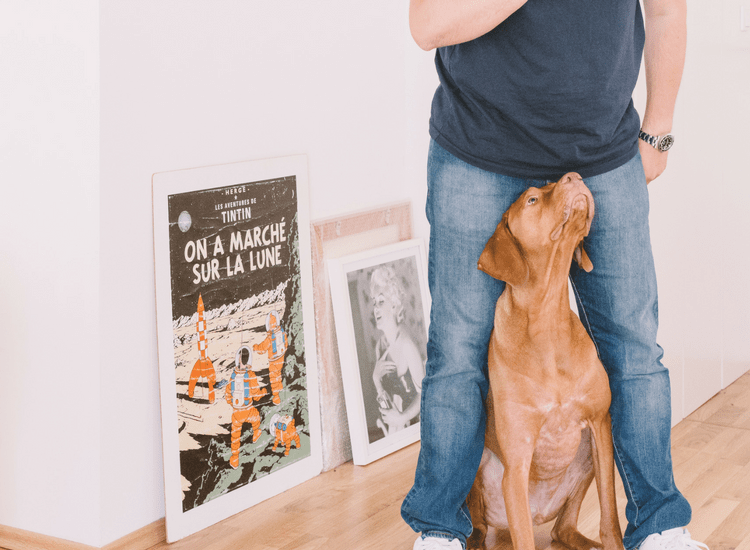At What Age Do Dogs Begin to Hump
Have you ever caught your dog humping something? Or maybe they were a little too excited and latched on to one of your unsuspecting limbs? Although this can be embarrassing for owners, it's certainly nothing to worry about. Occasional humping is perfectly natural behaviour for dogs.
Any dog can display humping behaviour during their lives. From males and females, and even puppies. They may prefer to mount each other, people, a cushion or their favourite cuddly toy. But besides the obvious, there are various reasons why dogs hump. This behaviour is actually more common than you'd think. It only becomes a real problem when the encounters are excessive or cause tension between dogs. In this article we'll explore some of the main causes, and instances when you might need to be concerned by your dog's humping behaviour.

Let's face it, a young puppy showing humping behaviour can be amusing or cute. But if you don't correct this behaviour early on, it can quickly turn into an unwanted habit in later years. Here are five reasons why your puppy may be getting a little too fond of your leg.
1. Practice for the real thing
Dogs reach sexual maturity at a very young age, (if compared to our own body cycles). At around 6 months of age, a dog hits puberty and is able to mate. So if your puppy mounts you, they may be feeling hormonal urges and getting in practice for things to come. That doesn't mean they're feeling a sexual attraction towards you, or the object or person they're humping; it could just as easily be a chair leg, a mop or the corner of your sofa. Their bodies are hardwired for eventual breeding. Humping can just be their way of preparing themselves for future mating.
2. Expressing anxiety
Being a puppy can be scary and stressful. They need to learn to cope around new people, sounds and objects as they find their place in the world. Puppies aren't born knowing how to process our modern family lives, it's our job to teach them how they fit in. So if you've just brought your puppy home, they may mount you or random objects as a coping mechanism—to relieve stress from being thrown into an unusual setting. Remember, they've just been taken away from their mother and siblings and may be feeling a little upset and overwhelmed.
All those new sounds, unfamiliar people and places can be daunting to your young puppy. So humping may also occur in new situations, such as when you have people around the house or you turn on the washing machine, for example.
3. Playtime and social learning

As puppies grow and develop with their siblings, humping, along with other playful actions such as nibbling or biting, can be a perfectly normal part of playful fun. This is generally where a dog learns the nuances of dog play and discovers what is and isn't acceptable.
As another example, puppies can be a little mouthy. They may nibble or bite each other as they explore the world, other dogs and people around them—similar to human babies! Their siblings will sometimes squeak or squeal to let each other know when the biting crosses the boundary between playful and painful; some dog behaviourists advise owners of new puppies to mimic this sound if a puppy's mouthiness becomes a problem.
It's important to allow puppies to spend enough time interacting with their siblings, as well as providing plenty of other opportunities to socialise with people and have a range of experiences. Check out our article which covers more information and advice on puppy socialisation. Not getting enough time to learn with their siblings can contribute to a dog growing up and showing signs of excessive play humping. When they play with us or other dogs, they don't understand what's good and bad doggy behaviour. This could mean they don't understand when the target means stop, or from being too overwhelmed by excitement or stress.
4. Attention seeking
A puppy may also hump you simply out of boredom or to seek attention. This problem can occur if you were guilty of spoiling your dog as a puppy. That cute, adorable face may have been too hard to resist and you fell into the trap of giving attention on demand. Now your dog may feel they have the right to seek attention whenever and however they please. Dogs are social animals and have evolved to want and need our attention, company and care. Humping your limbs may be one of several attention-seeking tactics (such as licking you for attention) that your dog uses to get more of the thing they want the most – your time and affection.
Consider if you're giving your puppy the right amount of physical and mental exercise. Puppies with high energy levels and nothing to do will seek ways to fill their time. If you give your puppy attention (whether positive or negative) while they're humping your leg, you're rewarding them for that behaviour.
When they know the tricks to get a response from you, you can bet your behind they'll keep practicing the same behaviour. Ensure you take your puppy out to explore the world everyday and occupy their minds at home with fun brain training activities. For example, a good way to channel there hunting instincts is through a game called "find it". Hide treats around your home and have your puppy use their incredible sense of smell to find them all.
As a puppy starts to walk at 2-3 weeks of age, they can sometimes display humping or similar behaviour. So by the time you bring your puppy home at 8 weeks, which is the recommended length of time a puppy should spend with it's mother and siblings, this might already have developed into a humping habit.
As your dog reaches sexual maturity and is capable of breeding at around 6 months, these urges may become stronger and more frequent. However, the breed of your dog plays an important role in the timescales for hitting puberty. Generally, smaller dogs mature much quicker than larger dogs. For example, a miniature poodle may become sexually mature at 6 months, but a Newfoundland may take 15 months or more. But not all puppies will start to hump so early in life. Some will develop the behaviour as they hit puberty and others never will. To minimise unwanted humping behaviour, you should aim to tackle the problem in those early puppy months. This will prevent the behaviour from becoming an embedded habit. Read on to discover our tips to manage and correct your dog's humping below.
Why do male and female dogs hump?

We often recognise humping as a strictly male and female pairing, but that's certainly not always the case. Some male dogs hump other male dogs, females will hump females, and even females hump males.
It's partly due to pure instinct and partly a learned behaviour. Whichever sexes are involved, the explanations are always the same.
1. Social interaction
Like puppies, humping can be due to elevated excitement levels during play. Meeting other dogs at the dog park can be such a cause for celebration, mounting or air humping may be your dogs form of release. In fact, during play some dogs will take it in turns to mount each other, and all participants are perfectly fine with it. Each dog respects and follows these rules of play so there's no need to intervene.
A momentary spell of humping is acceptable during greetings and play, as long as it doesn't lead to fights or bloodshed. And it's not upsetting the other dog of course. If the interactions get too heated between dogs and not everyone is happy, then you should lead your dog away to cool off.
2. Pleasure
Some dogs hump simply because they enjoy it. Intact (non neutered) males sometimes masturbate if they're prevented from approaching a female in heat. Perhaps to relieve their hormonal urges or out of simple frustration. Even dogs who've been spayed or neutered will practice humping for pleasure. In fact, neutered dogs are still physically able to get sexually excited.
When a dog learns that humping causes a pleasurable feeling, this can develop into a habit. Neutering may lower a dog's sex drive, but it doesn't entirely remove the joy they experience from stimulation. To correct excessive humping, you'll need additional training which we'll cover below.
3. Stress relief

All dogs have their own ways of dealing with stress and anxiety. Some will bark, tear things up or bite, but in other cases dogs use humping to cope in certain situations.
In particular, dogs can perform humping when initially meeting other dogs, whether at the park or in your own home. The apprehension of a first contact greeting can trigger their default method for stress relief – humping.
This stress response can also be triggered by separation anxiety, (when your dog is apart from you for long periods) or being fearful of loud noises. To find out if your dog's humping is stress related, you should watch out for other common stress cues while the humping occurs. Stress behaviours are most commonly associated with lip licking, yawning, and panting.
4. Compulsive behaviour
When humping has become your dog's obsession, the act has manifested into a compulsive habit. The behaviour can develop into a problem for many reasons. The most common being stress related, as well as isolation, lack of socialisation or abuse. Your dog may have become too used to humping as a way to handle their emotions, and the habit has spiralled out of control. When the behaviour affects your dog's everyday life and ability to function normally, the compulsion has become severe. Obsessive behaviours should be addressed by a qualified dog behaviourist.
5. Medical problems
In some cases, humping can be a response to a more sinister problem. Excessive humping of dogs, objects or people can be a sign your dog is uncomfortable and they're attempting to self-medicate. This could be something to watch out for if the humping is suddenly more frequent than normal.
These are possible medical issues associated with humping:
- Urinary incontinence
- Urinary tract infections
- Skin allergies
- Priapism
If your dog's humping is a new behaviour, be sure to consult a vet.
It's widely assumed that all dogs mount to secure their place in the social hierarchy. While some behaviourists believe humping is a display of dominance, others see no signs to support the theory. People often think more dominant dogs will mount more timid dogs. But others argue more often than not, it's the more anxious or socially insecure dogs that resort to humping. The stress of the situation becomes so overwhelming, they search for an outlet which triggers the humping. Perhaps some dogs do use humping as a form of dominance, but until we see concrete evidence to back up this claim we wouldn't want to speculate!

A humping dog can be awkward and embarrassing in certain company, especially if your grandma's around for tea. So we don't blame you for wanting to curb your dog's urges. Here are a few effective methods for easing your dog's humping:
1. Use redirection
If you're taking your dog to the park and you know they're likely to hump, come prepared. Bring a toy, a ball, or something that makes a loud noise. Like an empty water bottle half-full of pennies or a squeaky toy. If you throw a toy in front of your dog as they're humping, this will serve as a distraction to draw their attention away from the other dog. An empty water bottle when shaken will make a loud, startling noise and should break their focus.
Keep a close eye on your dog while they're playing with others. As they start to mount another dog, rattle the bottle or throw their favourite toy in front of them. This redirection technique will draw their focus away from the unwanted behaviour and onto acceptable interaction.
2. Enforce timeout
Another technique is simply pulling your dog away to cool off. As soon as they begin mounting, pull your dog off and hold them near you for two minutes to regain composure. You could also keep your dog on a long lead so they're easier to control.
3. Give a command
Getting your dog to listen to you all starts at home. Conduct regular obedience sessions and focus specifically on the "off" and "leave it" commands. Practice this training regularly in different environments to reinforce the behaviour. This will ensure your dog has a reliable response to the command every time.
The next time your dog starts to hump, you can simply say "off" and your dog will begin to understand the behaviour is unacceptable. Regular training also reinforces the bond between you and your dog. If they get into the habit of listening to you through positive training, they're more likely to follow the command in normal situations when you need it most.
4. Body block
Perhaps the easiest technique to use is the body block method. Your dog may have very distinct behavioural cues before they mount a person or dog. Maybe they wag their tail frantically, they bound up to the other dog, or sniff the other dog's private parts. Your dog's intentions may also be obvious if you've already disabled the mounting once and they're making a beeline for more. So before your dog can perform the behaviour, stand directly in front of the target. If they persist, gently use your leg to shoo them back. Never use force to the point you hurt your dog. You're simply breaking their momentary desire and showing them that behaviour is not tolerated.
5. Neutering or spaying your dog
As we mentioned earlier, neutering may not fix the problem altogether but it can drastically reduce the urge. Since humping is partly a learned behaviour as well as hormonal related, the after-effects of neutering will be part down to how long they've been practicing the behaviour. The question is, has it become an ingrained habit?
A 1997 study conducted by researchers at the University of California, Veterinary Medical Teaching Hospital found some encouraging results:
- In 57 dogs between 2 to 7 years of age, 40% saw a 90% decrease in mounting behaviour after neutering.
- In the other 60% of dogs, they saw a 50% decrease in humping behaviour.
Therefore, according to these results, neutering will reduce humping behaviour by at least 50%.
Whatever takes your dogs fancy, there's no question humping is a common problem behaviour. No matter how amusing it may sometimes seem. The most crucial thing you can do is understand the reasoning and take appropriate steps to prevent it. And if your young puppy is showing signs of humping now, your best chance of success is to use correction methods immediately. If you redirect the action now you'll ensure it doesn't turn into a lifelong habit.
You can count on Rover.com for plenty of articles about dog behaviour and caring for your dog, as well as, of course, local sitters who offer dog boarding—they're ready to step in when you're in a jam.
At What Age Do Dogs Begin to Hump
Source: https://www.rover.com/uk/blog/dog-humping-tips-advice-stop-unwanted-dog-humping/
0 Response to "At What Age Do Dogs Begin to Hump"
Post a Comment